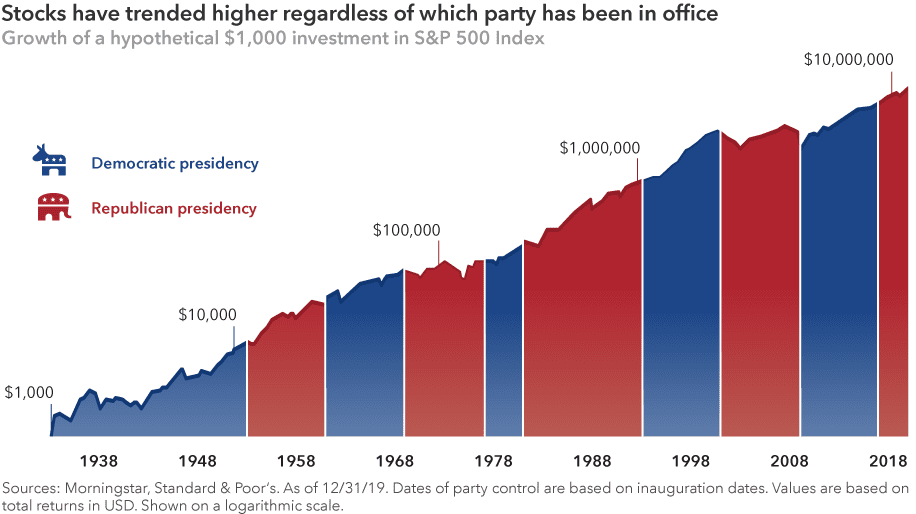Key Takeaways
- Historically, a bear market and a recession have not served the incumbent party well during elections.
- Markets don’t see red or blue but simply green. Since 1933, the markets, over the long-term, have gone up regardless of party affiliation, a sweeping win, or a divided party win.
- The factors that will dictate the markets include interest rates set by an independent Fed, continued innovation, and ongoing consumer spending—not simply presidential policies. Elections alone should not be the determining factor for investment decisions.
The 2020 US presidential elections are less than three months away. Against a backdrop of ongoing pandemic, social unrest, economic recession, and the fastest bear market to one of the fastest stock market recoveries, the 2020 presidential election couldn’t come at a more turbulent time.
Historically, a bear market and a recession have not served the incumbent party well. The chances of a win are higher if the markets and the economy are robust. Since 1900, according to Ned Davis Research, the incumbent party has won five times and lost nine when there was a 20% decline in the market or a recession in the election year versus a win of thirteen to a loss of three should these conditions not exist. The data is starker as we look at more recent history. Since 1952, the research finds that the incumbent party has never won when there was either a 20% decline or a recession[1]. Both have taken place in 2020. The question remains whether voters would consider the pandemic an external event or one for which the incumbent party was responsible.

In the event of a Biden win, one of the central concerns is higher taxes. Biden’s proposed tax plan would restore many provisions of the tax code prior to the passage of the 2017 Tax Cuts and Jobs Act (TCJA). Under Biden’s proposal, the corporate tax rate would rise to 28% from 21%, still below the 35% pre-TCJA rate. For individuals, the proposals would raise taxes on ordinary income for those making more than $400,000 a year, by returning the top marginal rate to 39.6%, where it was before the TCJA lowered it to 37%[2]. Whether such tax proposals are enacted hinges heavily on the outcomes of Senate elections and the state of the economic recovery especially in early 2021. If the economic recovery is slower than anticipated, it would likely result in the delay of tax rate increases until the economy was on more stable footing. Finally, while the two parties have traditionally taken different approaches to tax policy, deficits matter. Given the federal government’s extraordinary spending driving our debt and deficits higher to support the economy during the pandemic, further tax cuts are unlikely post-election.
Is one party better than another for markets?
An irreconcilable divide between the two parties has led to dire predictions of what will happen to America from both sides. Despite all the bluster, looking at modern history, the markets have gone up under most presidents. Since 1933, there have been seven Democrat presidents and seven Republicans. A long-term investor who ignored which party was in office would have benefited from staying invested[3]. It’s not that presidential policies don’t matter; it is that economic growth will continue even if there are policy mistakes. There are many other variables that determine economic growth such as monetary policy from the Federal Reserve (Fed). Currently, the Fed is aggressively supporting the economy with low interest rates and no indication of tightening monetary policy anytime soon.

What about a sweep or divided party win?
Now let’s take a look at the historical impact on markets when there is complete power by one party or under a divided scenario. The next chart gives us a look into the different scenarios’ impact on markets and has a clear message that regardless of the scenario, markets have gone up by roughly the same amount[4]. Shocking, but true.

Finally, many may think that’s all in the past and this time is different. Indeed, there are many important issues facing our country today; however, markets don’t see red or blue, only green. The factors that will dictate the markets include interest rates set by an independent Fed, continued innovation, and ongoing consumer spending – not simply presidential policies. Elections alone should not be the determining factor to investment decisions. In fact, the starting point in preparing portfolios for the elections is to take a step back and ensure you are appropriately allocated relative to your goals.
[1] Ned Davis Research
[2] Barrons: https://urldefense.com/v3/__https://www.barrons.com/articles/trump-biden-and-taxes-what-to-expect-1596843040?st=zfrj8r81qkke23q__;!!IqQPSucyZQ!KyPmpvgD6X2kW3cHFYe0euyIby9Wqqmtwz8-HZfbrnTkb9_3ZxPXzAI102P8bu5OXaRj$
[3] https://www.capitalgroup.com/advisor/ca/en/insights/content/articles/3-investor-mistakes-election-year.html
[4] https://www.fidelity.com/learning-center/trading-investing/markets-sectors/stock-returns-and-elections

